Meadow Cultivation - A much required technology transformation
 In a village like Mandali in the southern Rajasthan, where socio-cultural factors were very much relevant; villagers had to face high health care expenses, huge costs for hospitalization, sources of debts including the expenses for children education and the costs for daughter’s marriage. All these factors were a huge challenge for small and marginal farmers facing unemployment and having a land holding of 0.5 hectares or even less.
In a village like Mandali in the southern Rajasthan, where socio-cultural factors were very much relevant; villagers had to face high health care expenses, huge costs for hospitalization, sources of debts including the expenses for children education and the costs for daughter’s marriage. All these factors were a huge challenge for small and marginal farmers facing unemployment and having a land holding of 0.5 hectares or even less.
After observing the challenges in this area, Gayatri Seva Sansthan took the initiative of introducing the Meadow cultivation (High density plantation) practice in Mandali Watershed under IGWDP, NABARD, where they would be able to grow orchard crops in small piece of land and could gain more income through it. The basic idea behind this project was to ensure a better livelihood for the farmers with small landholdings and also to improve their standard of living. A native farmer of the village named Shri Nandlal permitted us to treat his barren land of about 0.2 hectares which was not suitable for his general farming practices and started the Meadow cultivation of Guava with all basic requirements for the cultivation and we acknowledged him with information of fertilization and pruning practices.
At times when some problems were faced by the farmers during this period of growth, we guided him with a proper remedy and treatments. The success of this initiative reflects in the Farm field of Shri NandLal, who adopted this new technique for the first time in Rajasthan on his barren land. Almost all the Guava plants in his field are growing quite healthy and have started bearing fruits also just one year after plantation. The income gained by Shri NandLal by adoption of this innovative idea has improved his standard of living quite well. Seeing the benefits of this new technique, two more farmers of the area adopted this method.
IADP - A successful pilot which turned ‘Agriculture as Livelihood’
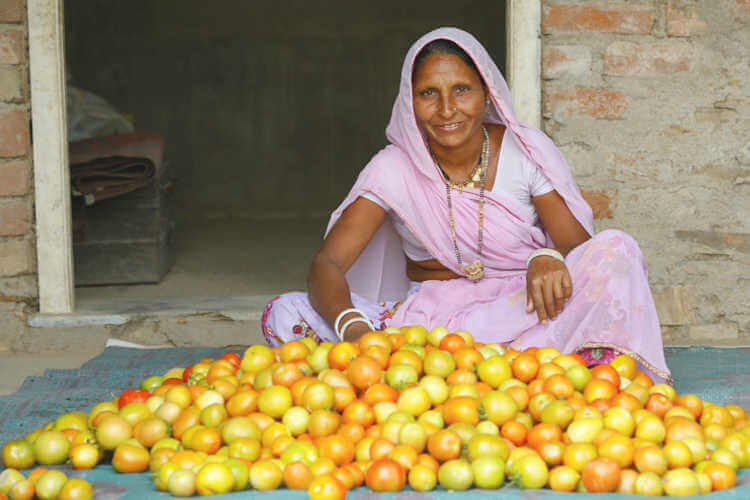 In the project areas under IGWDP lying over 31600 ha area in southern Rajasthan, majority of the farmers belong to small and marginal category. Most of the watersheds are in remote tribal areas where infrastructural facilities and access to extension services are very poor. Mandali was not an exception to this. Poor quality of inputs and unscientific pattern of farming made the livelihood in these harsh terrains highly vulnerable to climatic variability. In order to revive agriculture, which continues to be the major livelihood option, a pilot titled “Integrated Agriculture Development Programme (IADP)” was launched in Mandali watershed during Oct 2013.
In the project areas under IGWDP lying over 31600 ha area in southern Rajasthan, majority of the farmers belong to small and marginal category. Most of the watersheds are in remote tribal areas where infrastructural facilities and access to extension services are very poor. Mandali was not an exception to this. Poor quality of inputs and unscientific pattern of farming made the livelihood in these harsh terrains highly vulnerable to climatic variability. In order to revive agriculture, which continues to be the major livelihood option, a pilot titled “Integrated Agriculture Development Programme (IADP)” was launched in Mandali watershed during Oct 2013.
The pilot took off with formation of a 25-member Farm Field School carved out from Farmers Clubs formed in the watershed. Farmer-wise land used planning, improved cropping practices under guidance from experts during critical field operations, training locals as Para Agriculture Experts (Krishak Mitra), training women farmers and knowledge management through FFS are among the major activities.
The average earning of an individual farmer through the project is Rs0.75 lakh in a year from vegetable cultivation in only 0.05 ha area. All selected farmers are growing wheat, maize and cluster bean with improved package of practices (PoP). Two farmers successfully tried System of Wheat Intensification (SWI) technique.
After the success of the project in first year, this project was executed in 6 more places of the watershed.
Ber Budding
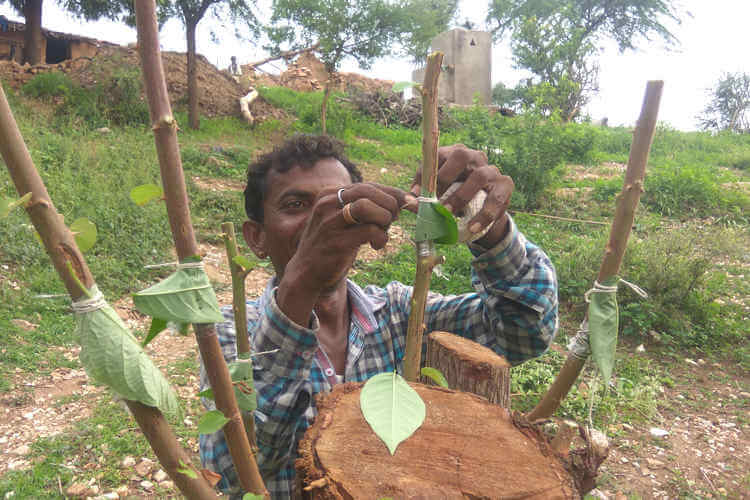 With the vision of improving livelihood in year 2012-13 IGWDP NABARD Rajasthan launched the ber budding activity in all watersheds on a campaign mode under the technical assistance from GSS, Udaipur. In Mandali watershed 305 trees have been converted successfully in to improved variety.
With the vision of improving livelihood in year 2012-13 IGWDP NABARD Rajasthan launched the ber budding activity in all watersheds on a campaign mode under the technical assistance from GSS, Udaipur. In Mandali watershed 305 trees have been converted successfully in to improved variety.
Ber whose botanical name is Ziziphus mauritiana is a multipurpose, economically important tropical fruit tree which is grown all over the drier regions of Indian subcontinent. The fruit is the most well-known and used product from the tree, however it is also a source of fodder, fuel wood, timber, medicines and potential industrial components1000. The fruit is rich in vitamins, minerals, calcium, iron and carbohydrates. The leaves of the ber tree are popular for fodder, especially in arid regions. They are very nutritious as well as grow and regenerate very quickly, even under stress conditions. Being a hardy species tolerant to harsh soil and environmental conditions, ber is an ideal option for augmenting the fodder availability for goats besides adding to the income and nutrition from ber fruits for local community in watershed area.
The average earning of an individual farmer through the project is Rs0.75 lakh in a year from vegetable cultivation in only 0.05 ha area. All selected farmers are growing wheat, maize and cluster bean with improved package of practices (PoP). Two farmers successfully tried System of Wheat Intensification (SWI) technique.
After the success of the project in first year, this project was executed in 6 more places of the watershed.
Micro Irrigation System
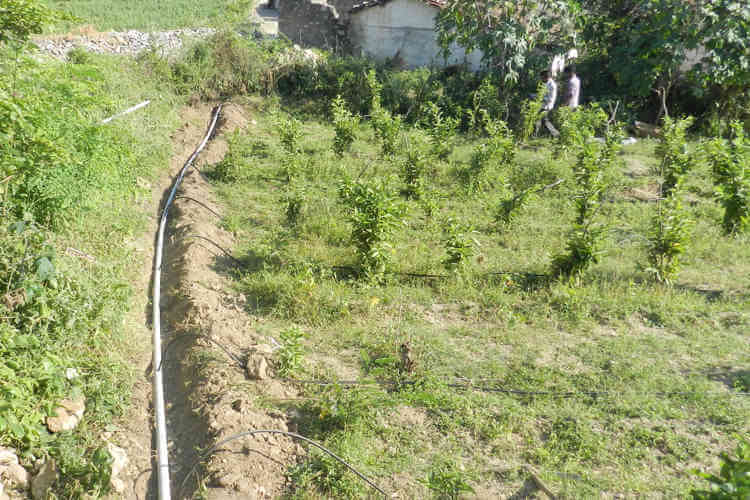 The area has lack of water availability due to which the farmers were facing huge problem in cultivation. To overcome this problem, GSS has introduced drip irrigation system first time in the entire region. Before the intervention of our team, there was not even a single installation of micro-irrigation system, but after 12 months of the project a unit of drip irrigation system was installed in project area. Due to timely installation of drip irrigation system, the farmers are able to make proper use of it. After experiencing such advantageous aspects of micro-irrigation system, there is a demand of more units of the drip irrigation installation in the area.
The area has lack of water availability due to which the farmers were facing huge problem in cultivation. To overcome this problem, GSS has introduced drip irrigation system first time in the entire region. Before the intervention of our team, there was not even a single installation of micro-irrigation system, but after 12 months of the project a unit of drip irrigation system was installed in project area. Due to timely installation of drip irrigation system, the farmers are able to make proper use of it. After experiencing such advantageous aspects of micro-irrigation system, there is a demand of more units of the drip irrigation installation in the area.
Goat Farming - Basking in the success of goat farming
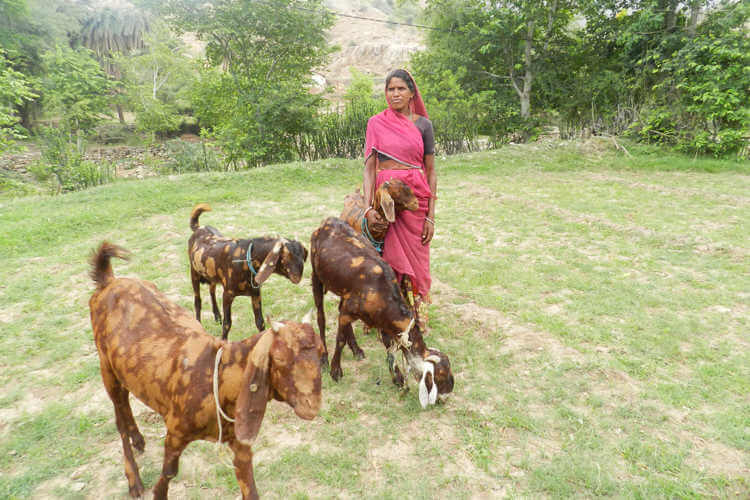 A group of farmers of “Mandali Watershed” were distributed a couple of goats of Sirohi breed for farming purpose during 2014 after the formation of Goat User Club (GUG). Sirohi goats are dual-purpose animals, being reared for both milk and meat. The animals are popular for their weight gain and lactation even under poor quality rearing conditions. The animals are resistant to major diseases and are easily adaptable to different climatic conditions. Starting with a stock of 30 goats and 12 bucks in the initial phase, the number of bucks was increased to 17 in the second phase. During the third phase, the number of goats and bucks increased almost double since the initial phase. Currently 20 families of the watershed are pursuing goat farming successfully.Goat farming is a lucrative venture, which does not require much attention in terms of feeding and management since they can be grown on locally available fodder and free grazing. However for obtaining the best results regular attention towards periodic deworming of goats and care of pregnant and new born goats is essential.
A group of farmers of “Mandali Watershed” were distributed a couple of goats of Sirohi breed for farming purpose during 2014 after the formation of Goat User Club (GUG). Sirohi goats are dual-purpose animals, being reared for both milk and meat. The animals are popular for their weight gain and lactation even under poor quality rearing conditions. The animals are resistant to major diseases and are easily adaptable to different climatic conditions. Starting with a stock of 30 goats and 12 bucks in the initial phase, the number of bucks was increased to 17 in the second phase. During the third phase, the number of goats and bucks increased almost double since the initial phase. Currently 20 families of the watershed are pursuing goat farming successfully.Goat farming is a lucrative venture, which does not require much attention in terms of feeding and management since they can be grown on locally available fodder and free grazing. However for obtaining the best results regular attention towards periodic deworming of goats and care of pregnant and new born goats is essential.
This initiative by Gss in this village has increased awareness among the farmers about the sirohi breed of goat and its benefits. Earlier they used to get low price for a single buck in the market i.e., 3-4 thousand. But after they are made aware of the optimum price, they easily get 7-8 thousand per buck.
These farmers are also provided with Goat card who are a member of Goat User Group (GUG). Animal health camps were organized to check the health of goats and bucks provided. Also, the animals were provided with proper nutrient feed and a manger for healthy feeding.
Rabbit Rearing - Brought them fortune
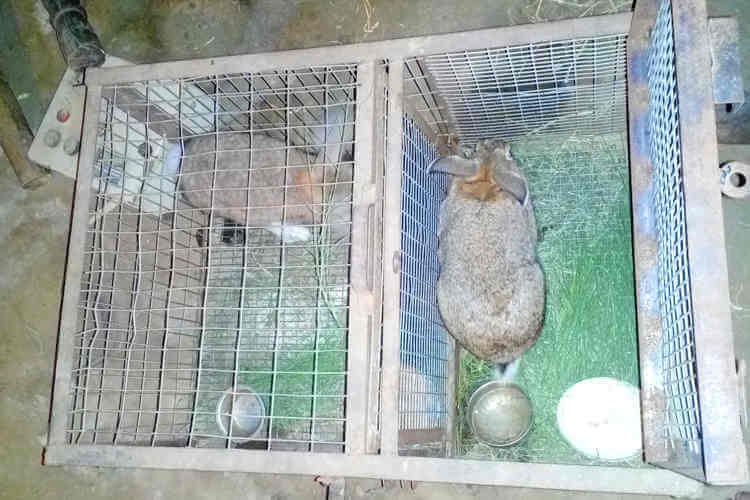 The idea of rabbit rearing in Mandali village was originated after the visit of agriculture department where the animal husbandry experts suggested about rearing of this dynamic animal. A single doe (female rabbit) can give birth to (litter) up to 40 kits (baby rabbits) in a single year. Unlike chickens, cattle and pigs, rabbits are not noisy animals. They are very clean animals and don’t easily get attacked by diseases.Above all, rabbits don’t require a lot of space like other livestock; it’s the ideal animal to raise in your backyard or any place with little space.
The idea of rabbit rearing in Mandali village was originated after the visit of agriculture department where the animal husbandry experts suggested about rearing of this dynamic animal. A single doe (female rabbit) can give birth to (litter) up to 40 kits (baby rabbits) in a single year. Unlike chickens, cattle and pigs, rabbits are not noisy animals. They are very clean animals and don’t easily get attacked by diseases.Above all, rabbits don’t require a lot of space like other livestock; it’s the ideal animal to raise in your backyard or any place with little space.
We took the technical assistance from RCA and Central Sheep & wool Research Institute - ICAR for the training purpose. After the training, 2 of the farmers were provided with 1 male and 2 female rabbits to each along with the single hutch(animal cage). After a year of rearing rabbits, the number has increased upto 25 to 30. One the farmer named Mr. Roshal Lal was interested in rearing of rabbits at commercial scale so we with the support of NABARD provided him with larger hutches. After the completion of 1 year, he owns around 40 units in his shade and now he is planning to extend this business into the markets nearby.
Wheat Intensification
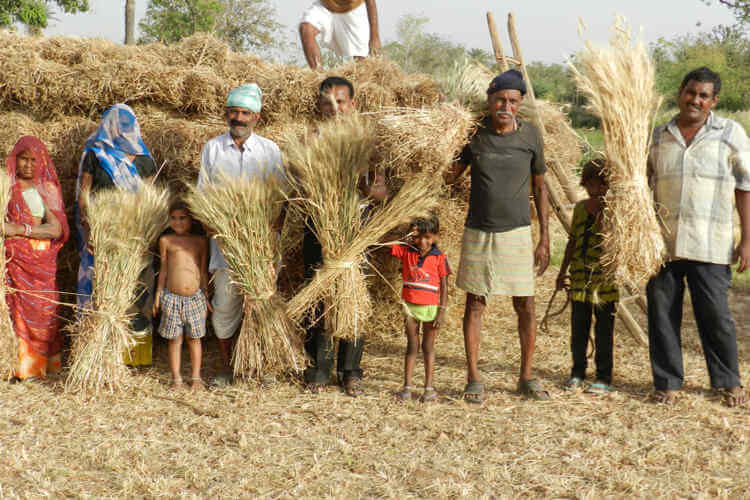 Being a village with maximum population under small and marginal farmer category, there was a need of wheat intensification against the small availability of land with minimum cost and high production results. To accomplish this task, we used the SWI technique – System of Wheat Intensification, a new concept on low input technology for increasing wheat yield in marginal land.
Being a village with maximum population under small and marginal farmer category, there was a need of wheat intensification against the small availability of land with minimum cost and high production results. To accomplish this task, we used the SWI technique – System of Wheat Intensification, a new concept on low input technology for increasing wheat yield in marginal land.
System of Wheat Intensification (SWI) is a new wheat cultivation technique which demands to maintain plant to plant distance at 8 cm and 20 cm between lines. This kind of sowing with proper plant density allows for sufficient aeration, moisture, sunlight and nutrient availability leading to proper root system development from the early stage of crop growth. After sowing, it is necessary to maintain plant population by gap filling and thinning of crowded seedlings. Besides this, 2-3 times weeding and irrigation is required for best results. These practices are carried in the early stage of wheat growth as associated with the principle of intensive care. System of Wheat Intensification (SWI) is one of the promising technologies to increase productivity which ultimately contributes to the household level food security of marginal farmers.
Water is Life
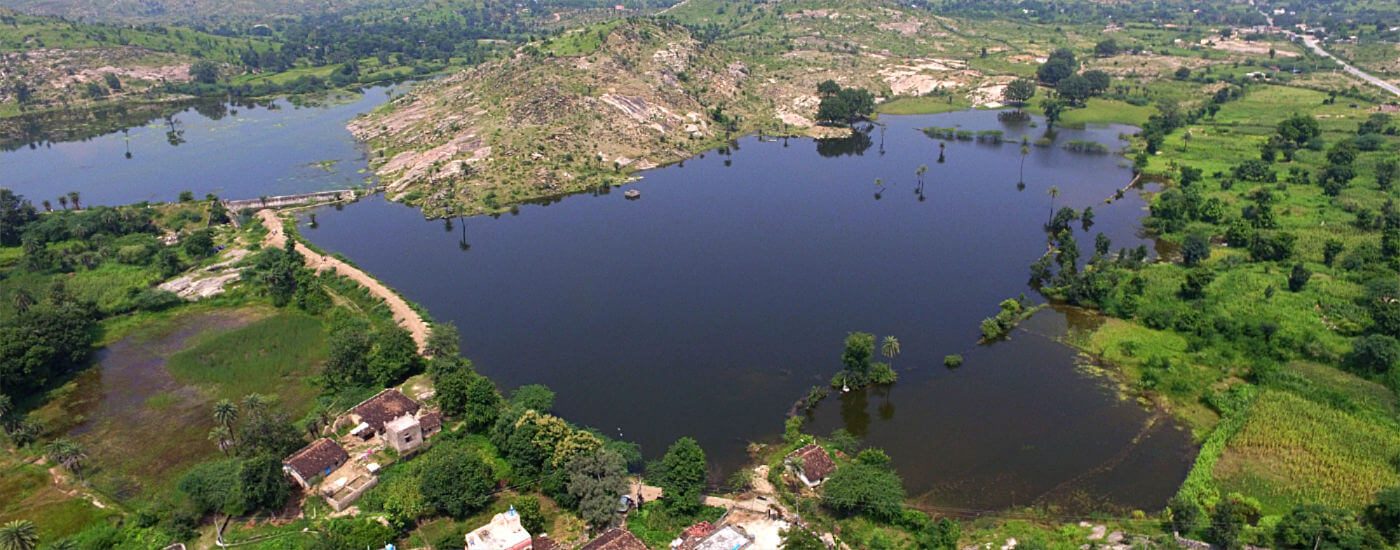 A few decades ago, Dayli (a village in Mandali Watershed) was facing a major water crisis because of irregular and erratic rainfall, which leads to drinking water insecurity, insufficient water for crop cultivation, etc. Attending to the urgent need, people in Dayli decided to go for less water intensive crops. Government also started initiating construction work for water conservation so as to fulfill the drinking and agricultural need for water. The increase in water level because of community level initiatives as well as government initiatives was evident and the community started to prosper.
A few decades ago, Dayli (a village in Mandali Watershed) was facing a major water crisis because of irregular and erratic rainfall, which leads to drinking water insecurity, insufficient water for crop cultivation, etc. Attending to the urgent need, people in Dayli decided to go for less water intensive crops. Government also started initiating construction work for water conservation so as to fulfill the drinking and agricultural need for water. The increase in water level because of community level initiatives as well as government initiatives was evident and the community started to prosper.
With time, the water harvesting structures wore apart, which again led to the same problem that was present 25 years back.
To minimize the effect of erratic and irregular rainfall, in 2015, Mandali Climate Proofing project, with the support of AFB and NABARD, was started. One of the aim of this project was to rejuvenate the existing structures and repair where necessary. The wreckage structures reconstructed through an adjoining wall constructed to main wall which block the seepage patches and desilting of earthy matter, fine sand which is carried by water and deposited as sediment. This has led to multiple other initiatives like agriculture, cooperative dairy, horticulture etc. A chain of benefits has unfolded many years of hard work put in by the Gayatri Seva Sansthan with the furtherance support of NABARD and AFB. Our efforts are paying off.
